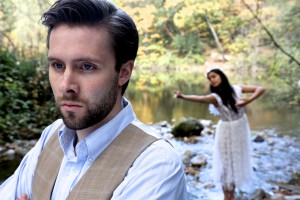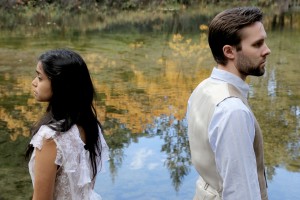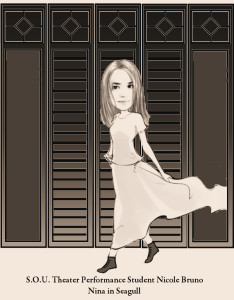Center Stage Theater’s Seagull
 Chekhov's Seagull
Chekhov's Seagull
Chekhov’s Seagull: S.O.U.’s Young Thespians Outperform Veteran Theater Stars
– by Lee Greene
On Thursday, Nov. 12, 2015, I had the privilege of attending the opening performance of Anton Chekov’s Seagull staged and performed by students of the Southern Oregon University (S.O.U.) Theater Department on the small thrust stage at the Center Stage Theater on the university campus. I was highly impressed by the production and the performances of the student thespians. The Russian author Chekov is considered to be among the greatest writers/playwrights in history, and The Seagull, written in 1896, is the first of his four classic plays. There’s been a lot written about the interesting backstory of the writing, debut, reception, and consequences for Chekov of this play, but I won’t go into it here as it’s not important to a review of this production. If you’re curious, I would refer you to the Wikipedia article about the play, and the references cited there. [Wikipedia, The Seagull, https://en.wikipedia.org/wiki/The_Seagull]
Two things ARE important enough to discuss here. First, the play was written in Russian, of course. And there have been numerous translations and adaptations in English.
Proliferation and confusion of translation reign in the plays. Throughout the history of Chekhov on the British and American stages we see a version translated, adapted, cobbled together for each new major production, very often by a theatre director with no knowledge of the original, working from a crib prepared by a Russian with no knowledge of the stage. [Peter France, The Oxford Guide to Literature in English Translation. Oxford University Press (February 2000), p. 600, quoted in Wikipedia, The Seagull, https://en.wikipedia.org/wiki/The_Seagull]
The version performed in the Center Stage Theater production is a new translation and adaptation by former Oregon Shakespeare Festival Artistic Director Libby Appel for the Shakespeare Festival in 2012 (and for the new version, the title was shortened from the historic The Seagull to just Seagull). It’s clearly one of the better translations and adaptations, not hobbled by the flaws cited in the criticism above. It’s certainly worth seeing, just so one has the benefit of having seen a well translated and adapted production of the great Chekhov play.
Secondly, it’s important to note that Chekhov’s plays “present a challenge to the acting ensemble as well as to audiences, because in place of conventional action Chekhov offers a ‘theatre of mood’ and a ‘submerged life in the text’.” [Wikipedia, Anton Chekhov, https://en.wikipedia.org/wiki/Anton_Chekhov] Chekhov’s plays represented a revolution in theater form, introducing a unique, very different way of presenting a stage drama from what had previously been normal in theater. And The Seagull, as the first of his four classic plays represented the cutting edge of this revolution. “In contrast to the melodrama of mainstream 19th-century theatre, lurid actions . . . are not shown onstage. Characters tend to speak in ways that skirt around issues rather than addressing them directly; in other words, their lines are full of what is known in dramatic practice as subtext, or text that is not spoken aloud.” [Wikipedia, The Seagull, https://en.wikipedia.org/wiki/The_Seagull] Chekhov’s play is quite a challenge for an actor, because the role must really be acted, rather than just lines learned and spoken – so much is unspoken. The audience must pay attention and think. The subtext is not spoken by the actors; the members of the audience must parse that for themselves.
Chekov himself described The Seagull as a comedy. It is actually a poignant tragicomedy, offering satiric wit, deep compassion and profound human drama. The focus of the play is on the intertwined, profound, and quite dysfunctional relationships among the ensemble cast of characters: the complicated relationship between would-be playwright, Konstantin Treplyov and his mother, the successful, vain actress, Irina Arkadina; Konstantin Treplyov’s love interest, Nina, the daughter of a rich landowner and herself a would be actress, and her love for the successful playwright Boris Trigorin, who happens to be Irina Arkadina’s companion of the moment; Masha, the daughter of the manager of the estate where most of the story is set, who loves Konstantin Treplyov; schoolteacher Medvedenko, who loves Masha; Polina, the wife of the manager of the estate, who loves the Doctor, Dorn; Sorin, brother of Irina Arkadina and uncle to Konstantin Treplyov, who owns the estate where most of the story is set; and Ilya Shamrayev a, a retired Army officer who manages the estate and is husband to Polina and father of Masha.
Having noted the challenge presented by this play, I have to say this was a superlative production. S.O.U. Theater Professor Jackie Apodaca did a terrific job of directing this production and leading the student cast to brilliant and memorable performances. I have seen other productions of The Seagull, most notably the 1975 Williamstown Theatre Festival production featuring an all-star cast (Blythe Danner, Frank Langella, Lee Grant, Kevin McCarthy, Olympia Dukakis, etc.) preserved on film by The Broadway Theatre Archive and available to view on YouTube (https://www.youtube.com/watch?v=qiPfPzt8azc). You might think it would be difficult for a cast of young theater students to muster performances rivaling that of such acclaimed, award-winning veteran actors. But let me tell you, the Center Stage cast rose to the challenge and produced a memorable production with numerous outstanding performances.

Connor Bryant as Konstantin Treplyov and Nicole Bruno as Nina in Center Stage Theater’s production of Chekhov’s Seagull
The role of Nina has served as a springboard launching or accelerating the careers of more than a few actresses over the years [e.g., Uta Hagen made her Broadway debut in the role at the age of 18 in 1938 at the Shubert Theatre ; Romola Garai played the role in a 2007/2008 production of the Royal Shakespeare Company and received rave reviews, “The Independent calling her ‘a woman on the edge of stardom.’” [Wikipedia, The Seagull, https://en.wikipedia.org/wiki/The_Seagull] I would not be the least bit surprised if the role turned out to be the beginning of a long and successful career for the actress who performed the role in the Center Stage Theater production, Nicole Bruno.
From the moment she made her first entrance, bounding onto the stage with enthusiastic energy and leaping up into the arms and embrace of the waiting Konstantin Treplyov (Connor Bryant), Ms. Bruno’s performance was a winner, irresistible and unforgettable. My copious notes taken during the performance are just filled with positive observations, plaudits, and awe at Ms. Bruno’s performance. She brought to the role a very beneficial exuberance and energy, displayed a wide range of very effective and wonderful facial gestures, and did a masterful job of delivering the several monologues Chekhov has scripted for the role as well as more than carrying her own weight in the various dialogues with Konstantin Treplyov which are at the heart of this play. I just have to say this, because it’s true: I liked Ms. Bruno’s performance in the role better than that by the great Blythe Danner.

Nicole Bruno as Nina and Connor Bryant as Konstantin Treplyov in Center Stage Theater’s production of Chekhov’s Seagull
If the play can be said to have a central character, it would be the Konstantin Treplyov role, which is the keystone around which all the other characters revolve. Connor Bryant did his part to deliver a good depiction of that role. It was a well done, believable and memorable performance of a character, who is written in a prototypical Russian fashion as an almost overwrought, over-emotional neurotic; a part very tempting and easy for an actor to overact. Mr. Bryant delivered a very restrained nuanced performance, and avoided overacting at every turn. Again, my copious notes are filled with kudos for Mr. Bryant’s performance: “good acting”, “good use of hands”, “excellent facial gestures”, “really inhabiting the role”, etc.
At points in the story where I felt the Treplyov role by Frank Langella in the Williamstown Theatre Festival production was marred by histrionics and overacting, Mr. Bryant, by contrast, hit just the right tone, getting Chekhov’s meaning across without overdoing it.
But this is really an ensemble piece and there was lots of work by the many actors and actresses in the cast, and many more fine performances beyond those two. Tamra Mathias as Irina Arkadina and Devin White as Boris Trigorin both provide notable well-done performances; a highlight of the production is their very entertaining and amusing scene where Arkadina attempts to seduce Trigorin, who has been consorting with the younger Nina. Henry Steelhammer played Sorin, and I have to say I enjoyed his performance in the role more than that of any other actor I have seen play the part. He made the character interesting and compelling to watch, where other actors have not had that degree of success with the role. The character undergoes a gradual deterioration over the course of the play, and Mr. Steelhammer did a terrific job of depicting that progression. Dorn, the doctor, is given some of the best lines in the play and some significant monologues. Jon Cates gave a performance in the role that did justice to the character’s contributions to the story and more than held his own with the rest of the cast of characters.
Rebecca Curtis as Masha, Reid Honeywell as Medvedenko, Valerie Huntington as Polina, Taylor Hood as Ilya Shamrayev, Kyle Sanderson as the hired workman Yakov, Brianca Knight as the Housemaid, and Sofie Kline as the Cook all rendered fine performances. There wasn’t a single clunker on stage throughout the entire production. The greatest praise, though, must be reserved for Director and teacher, Jackie Apodaca. What an accomplishment, to get such consistently delightful performances from such a young cast of student actors in a complex Chekhov play.
This is a production well worth seeing. It is a classic play, by a great playwright, in a superb translation/adaptation, given wonderful life on the stage in an outstanding production. Everyone interested in theater should see at least one good production of Chekov’s landmark theater-altering play, The Seagull. If you haven’t seen one yet, I strongly encourage you to go see this one. If you have, you may, just like me, find some of the performances in this production of Seagull to outshine those of some of the accomplished actors and actresses you’ve seen in the roles before in other productions. Additional performances of Seagull are scheduled for Thursday, Friday and Saturday, November 19 through 21 at 8 pm. and Saturday and Sunday, Nov. 21 and 22 at 2 pm. at the Center Stage Theater on the S.O.U. campus at Mountain Av., Ashland. Tickets are available by calling 541-552-6348 or online at http://bit.ly/1KlTDOr.




